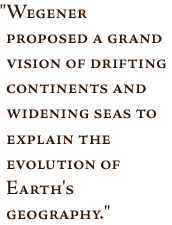

|
"Doesn't the east coast of South America fit exactly against the west coast of Africa, as if they had once been joined?" wrote Wegener to his future wife in December 1910. "This is an idea I'll have to pursue." The following fall Wegener came across scientific papers promoting the prevailing theory that Africa and South America had once been connected by a continent-size land bridge that had since sunk into the sea. They cited as evidence fossils of identical animals that had lived in both areas simultaneously hundreds of millions of years ago.
Wegener was fascinated and searched out other papers about such continental coincidences. As he read, his earlier conjecture that the continents had once been joined became a conviction he would boldly champion for the rest of his life. Just a few months later, on January 6, 1912, Wegener startled a meeting of the Geological Association in Frankfurt with his radical theory. Dismissing the concept of sunken land bridges, he proposed instead a grand vision of drifting continents and widening seas to explain the evolution of Earth's geography. Four nights later he made a similar presentation to the Society for the Advancement of Natural Science in Marburg, Germany. Wegener had launched a revolution—and he knew it. Just two weeks earlier, he had written his future father-in-law, eminent climatologist Wladimir Koppen, "if it turns out that sense and meaning are now becoming, evident in the whole history of the Earth's development, why should we hesitate to toss the old views overboard?" next: Resume of a Revolutionary
|
 On the Shoulders of Giants
| ||